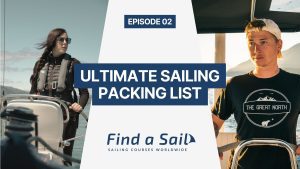Imagine this: First day of that long-awaited charter holiday. You’re a few miles offshore, conditions are changing fast, the boat is laying on its ear, and your crew is frantically rummaging through the forepeak to figure out where the lifejackets are stored. How many do we have? What type? Well, no one knows how to use them anyway.
Up in the cockpit, another crewmember is sitting on the leeward coaming clinging to the lifeline, looking visibly frightened (as they should be). In the middle of the chaos, a desperate face pops out of the heads door—it’s clogged!
Let’s rewind an hour. Mayhem like this can be avoided entirely with one crucial step—a thorough safety briefing conducted before you set sail.
Why a Safety Briefing Matters
Safety briefings aren’t just legal formalities—they’re a skipper’s best ally. Sure, they are mandatory, but they also set the tone for the entire trip. A good briefing equips your crew with the confidence and knowledge to handle onboard systems and participate actively—building them into a team. As a skipper, you already have your hands full, so offloading some responsibility onto your crew allows you to focus on navigating or dealing with more complex tasks. It makes everyone’s life onboard smoother.
That’s why I believe a great week on the water starts with a solid briefing.
The What: Cover the Essentials
A safety briefing doesn’t just cover safety essentials; it’s also an opportunity to introduce yourself and your style to the crew, helping them get acquainted (and fall in love) with the plastic bucket they’ll call home for the next week.
Here’s what to cover:
- Safety Equipment: From lifejackets to fire safety, first aid, and emergencies, these are the absolute essentials.
- Boat Life: Help everyone settle in by explaining the heads (for your own sake!), showers, stove, water and electricity use, food storage, cooking, and cleaning routines.
- Boat Systems: For the interested, discuss the nav station and electronics, bilge pumps, tools, radio, and engine operation.
- Essential Skills: Teach handling winches, cleats, moving on deck, and avoiding the boom—equipping your crew with basic helpfulness.
The When: Do It Before You Sail
The best time to deliver a safety briefing is while still in the harbor. Conditions can change quickly at sea, and you don’t want to be fumbling for safety gear in an emergency while teaching everyone how to use it. Plus, you might no longer be with them.
Sure, it might take the initial hour out of your holiday, but covering these details while the boat is steady and calm is a time investment well worth it. Trust me, I speak from experience.
The Why: Turn Briefings Into Confidence Boosters
A good safety briefing isn’t just about safety—it’s about equipping your crew and fostering teamwork, making everyone’s time on the water far more rewarding. Plus, it will protect your sanity down the line.
The Ultimate Safety Briefing Checklist
Purpose: This comprehensive safety briefing checklist is designed to ensure your crew’s safety, build their confidence, and introduce them to life on board. Cover all points before setting sail—and encourage questions. If you make it fun & hands-on, they will actually remember it!
Below Deck Safety Briefing
- Alcohol Policy 🍷
- Same limits as on the roads apply to both skipper and crew (there are no passengers).
- No drinking while sailing. Docked? We are responsible adults, but moderation is key due to inherent risks.
- Allocation of Gear and Food Storage 🧳
- Explain designated areas for personal items and where provisions are stored.
- Water Usage 💧
- Highlight limited water resources.
- Encourage personal water bottles and staying hydrated.
- Heads (Toilets) 🚽
- Operation & usage rules: “If you haven’t eaten it first, don’t flush it” (toilet paper in moderation).
- No peeing overboard.
- Proper use of the shower drain.
- Gas Procedure 🔥
- Gas bottle storage and valve operation.
- Safe practices: No leaning over the stove; keep surroundings hazard-free (e.g., tea towels).
- Demonstrate stove operation, including the gimbal, ensuring gas is off at the valve when not in use.
- Cleaning Routine 🧹
- Shared responsibility for dishes and cleanliness—no martyrs.
- Stress the importance of cleaning messes to prevent safety hazards on floorboards.
- For the sake of everyone’s sleep, suggest being careful about noise at night (washboards!).
- Batteries and Power Management 🔋
- Explain battery switches: domestic and starting.
- Stress power conservation and explain phone charging policies.
- Fire Safety 🚒
- Identify fire sources (stove, engine, electrics, smokers).
- Demonstrate fire blankets, extinguishers, and buckets—locations and proper use. Include smoke, gas, and CO detectors.
- Evacuation plan: Alarm, wake aft cabins, assembly point, emergency exits.
- Hatches and Stowage 🔐
- Hatches to remain shut at sea. Demonstrate proper operation.
- Stowage: Close lockers and ensure nothing will fall or fly around in a seaway.
- Delegate a crew member to “get the boat ready for sea.”
- First Aid Kit 🩹
- Locate the kit and identify trained personnel onboard.
- Stress reporting injuries to the skipper. Discuss medical conditions privately if necessary.
- Navigation Station 🗺️
- Explain VHF operation and Mayday procedures. Cover the switchboard and instruments.
- Emphasize keeping the navigation area tidy. It is a dry area and the skipper’s playground.
- Flares 🎆
- Indicate location. Usage will be covered separately during the week.
- Bilge Pumps 💦
- Demonstrate location and use.
- For advanced levels: Identify through-hulls and seacocks.
- Tools 🛠️
- Show tool locations.
- Lifejackets 🦺
- Demonstrate proper wear and use, including tethers. Assign each crew a lifejacket for the week and stress their responsibility for it.
- Discuss when to wear & clip on (whenever you prefer, night, conditions, when skipper says so, non-swimmers…).
- On Charter vessels, inspect all inflatable lifejackets together (issues are common).
- Location of spares.
On Deck Safety Briefing
- Winches and Clutches ⚙️
- Demonstrate winch use for sheet and halyard handling.
- Stress small fingers vs. big sails. Little finger toward the load. Add friction to reduce strain; let go if overwhelmed. No wrapping lines around wrists.
- Clutches: Open only when the line is secured and locked on a winch.
- Sailing Gloves 🧤
- Recommend gloves to prevent rope burns.
- Securing Lines and Stepping Ashore 🪢
- Demonstrate cleat hitches and have the crew practice. Stress holding onto shrouds and no stepping over lifelines until the boat is stationary.
- Never jump ashore; use cleat friction to control the boat in windy conditions.
- Safety Equipment 🚨
- Discuss the life raft and Man Overboard (MOB) equipment.
- Engine Operation ⚡
- Cover starting, stopping, and throttle control.
- Moving Around the Boat 🛟
- Stress keeping the center of gravity low, using one hand for the boat and one for tasks. Always move on the windward side when outside the cockpit.
- Highlight trusted points for support: jack stays, handrails, shrouds, pushpit/pullpit, cleats, mast.
- Warn against trusting lifelines, stanchions, and running rigging.
- Highlight slippery hatches and the risk of injury.
- If barefoot, caution against kicking toes on hardware.
- Dangers ⚠️
- Identify risks: Boom, open hatches, and tripping hazards.
- Sails ⛵
- Explain sail locations, types, and basic controls.
- Anchor ⚓
- Demonstrate location and usage.
Final Step
- Delegate a second-in-command—in case the skipper is incapacitated or goes overboard, this person will take charge.
- Indicate in the logbook that the safety briefing was completed. Have all crew members sign to confirm their understanding.
A Smarter, Safer Crew
A thorough safety briefing empowers your crew, turning them from passengers into capable contributors. When everyone knows their role, the journey becomes smoother, safer, and more enjoyable. So next time you prep to sail, make your safety briefing a priority—you’ll be glad you did.
Would you like to try it in action, but unsure about the best sailing course for you? Take our quiz to find out!



